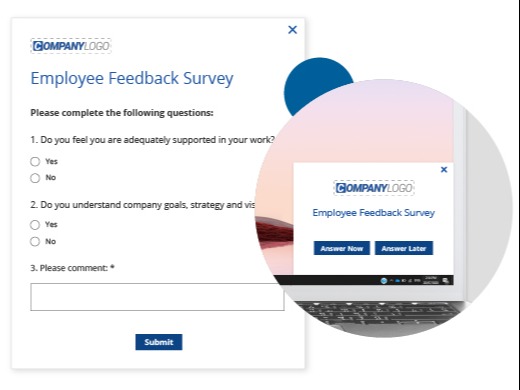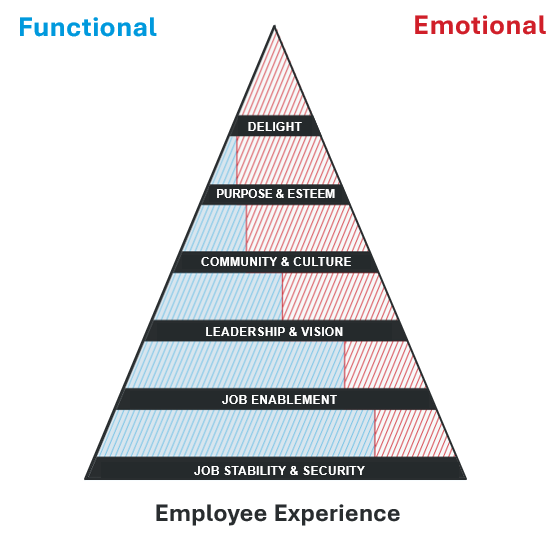
Improving and maintaining employee engagement efforts is an ongoing challenge for organizations. A ‘one-size fits all’ approach just doesn’t work.
Hybrid working and increased numbers of remote workers mean on-site office perks have lost their appeal. Employers need to find new ways of driving engagement.
What are the benefits of employee engagement? Highly engaged businesses have 81% less absenteeism and 14% higher productivity.
Consider this: When your staff wake up for work, what are they more likely to think? “Awesome, let’s get into it!” or “Ugh, what illness can I feign to stay home today”? If it’s the latter, you have a bad case of disengagement.
If your organization is struggling with low engagement, we have some best practices you can use to turn things around. We’ll also help you understand why you may have an engagement issue, and how you can prove it. Sound good? Then let’s go!
Contents:
- What is Employee Engagement and Why is it Important?
- 5 Employee Engagement Statistics
- 3 Levels of Engagement
- Drivers of Engagement
- How to Measure Engagement
- 6 Best Practices for Improving Employee Engagement
What is Employee Engagement and Why is it Important?
Employee engagement is the positive sense of connection a person has towards their work. It’s reflected in their attitude, effort and involvement.
Research has proven time and again that higher employee engagement positively influences organizational success. That’s because an engaged workforce is more vested in the outcomes. That in turn results in better customer satisfaction, greater productivity and stronger ROI.
Remember though, that engagement isn’t synonymous with happiness. An employee who is happy or satisfied may be content with the status quo and not seek out new opportunities, but an engaged employee will. Happiness and job satisfaction are important, but they’re not a good measure of employees’ attitude and behaviors.

5 Employee Engagement Statistics
If that isn’t enough to inspire you, try these essential employee engagement statistics that every manager should know.
1. 80% of your people problems come from 20% of your low-performing employees.
Engaged employees contribute more to the success of the company by investing discretionary effort, time and energy into their roles.
2. Only 21% of employees are engaged at work.
Today’s workers aren’t finding enough meaning in their work, according to Gallup’s most recent State of the Global Workplace report.
3. Roughly 20% of employees quit within the first 45 days of employment.
Poor onboarding and training fails to male new hires feel part of the team or instill any commitment to the organization’s success.
4. Disengaged employees cost the world $7.8 trillion in lost productivity last year.
That cost represents a staggering 11% of global GDP, according to Gallup’s State of the Global Workplace report.
5. 42% of employees are actively looking for new opportunities outside their organization.
In a competitive job market, employers must consider the broader working environment to retain their best staff.

3 Levels of Engagement
There are three levels of employee engagement: highly engaged, not engaged and actively disengaged.
1. Highly engaged
These employees are passionate, involved in projects, offer new ideas and problem solving, don’t shy away from challenges, and often go above and beyond what’s expected of them. They’re positive brand advocates, with a genuine pride in the organization and its mission.
2. Not engaged
Employees who fulfill their job duties, but usually need to be encouraged to become more involved. They are generally neutral about the organization, and require a push in the right direction to be inspired and engaged.
3. Actively Disengaged
Negative, dissatisfied employees who complain often, don’t attend team-building events, avoid development or project opportunities, and are potentially actively looking for a new job. They have low levels of productivity, low morale, and aren’t aligned with the company's purpose or mission.
As an HR Manager, you should have strategies in place for each of these to encourage employees in progressing to higher levels of engagement.
Drivers of Engagement
There are many factors that influence employee engagement, but they can be grouped into two areas, which we’re calling the who’s and the what’s.
1. Who (people)
This includes caring managers, attentive HR departments and good leaders. Of these, managers are the primary drivers of engagement. Employees who receive daily feedback from their manager are 3x more likely to be engaged than those who receive feedback once a year or less.
2. What (activities, tools, software)
This is a broad area encompassing having a sense of purpose, career development, and open dialogue around roles and company direction. It’s closely related to employee experience – if an employee’s experience with their organization is poor, their engagement will be too.
How to Measure Engagement
Measuring engagement should be built into a regular cadence. As a minimum you should be surveying your employees on a quarterly basis, through pulse surveys and lifecycle surveys.
In addition to this, you should also be tracking metrics such as readership and open rates on your employee communication messages.
Some methods you can use to measure engagement include:
- Free-form answers in surveys
- Focus groups
- Discussion forums
- Control groups
Online employee surveys are especially useful, as their flexible question formats and simple data exporting make it easy to collect insights. Pop-up notifications typically generate higher response rates than traditional email or browser-based surveys.

6 Best Practices for Improving Employee Engagement
1. Be intentional about survey questions asked
If you truly want to move the engagement lever, listen and make changes based on employee feedback. The better the question, the better the answers. Keep it open; keep it honest.
2. Celebrate your employees' achievements
When employees see their efforts praised, they are more likely to contribute. Make sure you share the love in newsletters and Slack channels. From smashing KPI’s to work anniversaries and birthdays, celebrate it all.
3. Follow up on feedback
Don’t survey staff and ask for feedback if you aren’t going to address it. Respond to feedback with messages from leadership. No one will provide feedback if nothing is done with it.

4. Make an ongoing commitment
Engagement isn’t a one-and-done activity. It’s not a couple of surveys and team-building events scattered throughout the year. Have strategies which aim to address the key areas which affect engagement, encourages honest two-way communication, and provides education when necessary (e.g. ensure managers have good soft skills).
5. Keep everyone in the loop
Make sure you use multiple channels to reach your employees with company updates. From product launches to KPI updates, informing your employees of what’s going on within the organization helps them feel connected and invested.
6. Use a range of communication channels
Internal communication channels are your best friend when it comes to improving engagement and increasing awareness. Keep your finger on the pulse with surveys, use alerts for critical updates, circulate newsletters for general updates, and keep staff connected.

Download our exclusive whitepaper for more on building an engaged workforce, plus EX research results and dozens of practical tips and examples.
Download: 6-Part Framework to Improve Employee Experience


